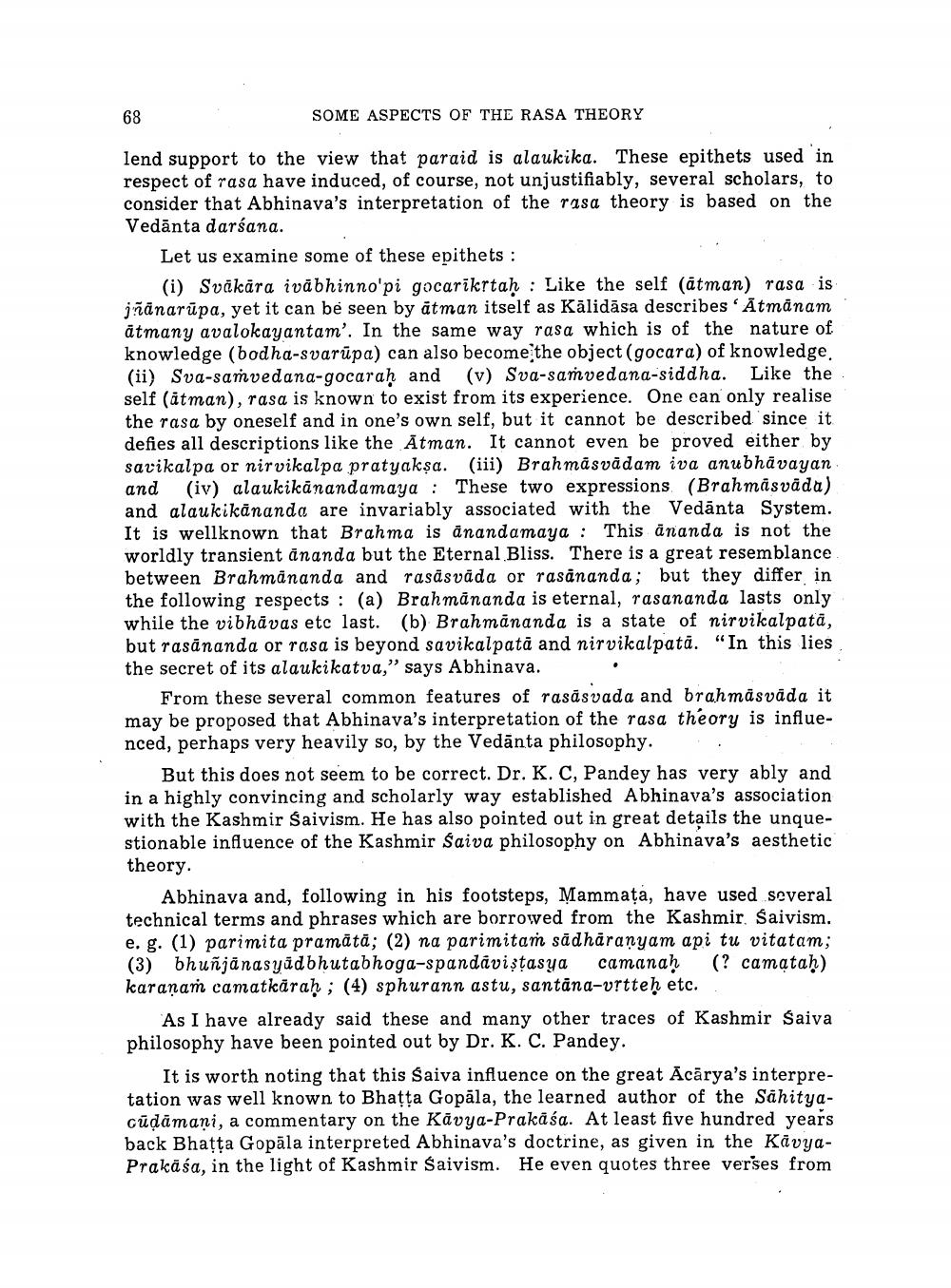________________
68
SOME ASPECTS OF THE RASA THEORY
lend support to the view that paraid is alaukika. These epithets used in respect of rasa have induced, of course, not unjustifiably, several scholars, to consider that Abhinaya's interpretation of the rasa theory is based on the Vedānta darśana.
Let us examine some of these epithets :
(i) Sväkära iväbhinno'pi gocarikrtah : Like the self (atman) rasa is janarūpa, yet it can be seen by ätman itself as Kālidāsa describes 'Atmanam ātmany avalokayantam'. In the same way rasa which is of the nature of knowledge (bodha-svarūpa) can also become the object (gocara) of knowledge. (ii) Sva-samvedana-gocarah and (v) Sva-samvedana-siddha. Like the self (atman), rasa is known to exist from its experience. One can only realise the rasa by oneself and in one's own self, but it cannot be described since it defies all descriptions like the Ātman. It cannot even be proved either by sarikalpa or nirvikalpa pratyaksa. (iii) Brahmāsvādam iva anubhāvayan and (iv) alaukikānandamaya : These two expressions (Brahmåsväda) and alaukikānanda are invariably associated with the Vedānta System. It is wellknown that Brahma is anandamaya : This ānanda is not the worldly transient ånanda but the Eternal Bliss. There is a great resemblance between Brahmananda and rasāsvāda or rasānanda; but they differ in the following respects : (a) Brahmananda is eternal, rasananda lasts only while the vibhāvas etc last. (b) Brahmananda is a state of nirvikalpatā, but rasānanda or rasa is beyond savikalpatā and nirvikalpată. "In this lies the secret of its alaukikatva," says Abhinava.
From these several common features of rasāsvada and brahmäsvāda it may be proposed that Abhinava's interpretation of the rasa theory is influenced, perhaps very heavily so, by the Vedānta philosophy.
But this does not seem to be correct. Dr. K. C, Pandey has very ably and in a highly convincing and scholarly way established Abhinava's association with the Kashmir Saivism. He has also pointed out in great details the unquestionable influence of the Kashmir śaiva philosophy on Abhinava's aesthetic theory.
Abhinava and, following in his footsteps, Mammața, have used several technical terms and phrases which are borrowed from the Kashmir. Saivism. e. g. (1) parimita pramātā; (2) na parimitam sādhāranyam api tu vitatam; (3) bhuñjānasyādbhutabhoga-spandāvistasya camanah (? camatan) karanaṁ camatkärah ; (4) sphurann astu, santāna-vrtteh etc.
As I have already said these and many other traces of Kashmir Saiva philosophy have been pointed out by Dr. K. C. Pandey.
It is worth noting that this Saiva influence on the great Ācārya's interpretation was well known to Bhatta Gopāla, the learned author of the Sahityagūdāmani, a commentary on the Kavya-Prakāśa. At least five hundred years back Bhațţa Gopāla interpreted Abhinava's doctrine, as given in the KavyaPrakāśa, in the light of Kashmir saivism. He even quotes three verses from




